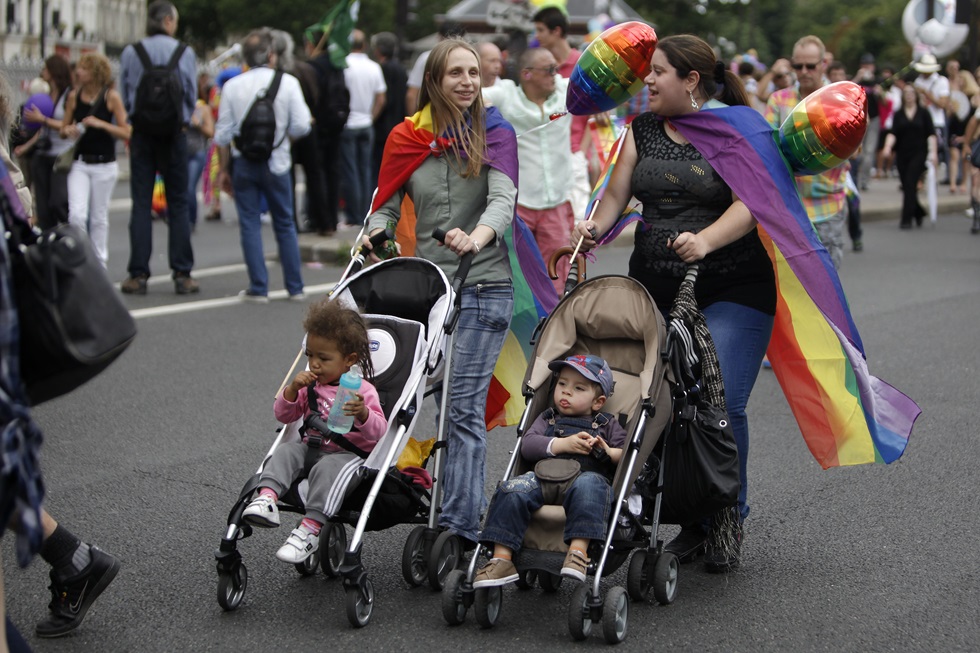
In the space of three decades, from the mid-1980s to 2015, U.S. mainstream public opinion and the political, social, and legal status of the LGBTQ community changed dramatically. Lesbian, gay, bisexual, and transgender people went from being a reviled, persecuted, criminalized, pathologized, and excluded group, politically and legally, to gaining status as equal rights-bearing citizens under the U.S. Constitution and in governmental policy.
These changes were part of a much more significant social upheaval that broke down the post-WWII hierarchical, patriarchal, and racist worldview shaped by Jim Crow racism and the Cold War anti-communism of the Red Scare and anti-gay hysteria during the Lavender Scare and resulted in broad gains for civil, women’s, immigrant’s, disabled, and environmental rights.
Vast changes in mainstream attitudes, mores, and public opinion, not just concerning LGBTQ rights, were necessary to win sweeping legislative and legal victories. How did this change occur? How did public attitudes and opinions flip quickly, allowing for historic political and legal advances for the LGBTQ community?
Susan Burgess, a distinguished retired Ohio University professor, author, political scientist, and LGBTQ activist, explores this question in her thoughtful and insightful book, LGBT Inclusion in American Life. She shows how these complex and dynamic changes happened over time through the active “mutually constitutive” intersection of ideas, politics, and popular culture.
For example, “changing attitudes toward sexual privacy and mores opened the door for people to be inclusive of gay love.”
Class and democratic struggles, including LGBTQ rights, are fought out in the economic, political, and ideological realms, of which popular culture is a huge part. Popular culture broadly reflected these struggles and changes, including the conflict between traditional mainstream and radical new ideas.
The dynamic cultural conflict, in turn, impacted vast swaths of American public opinion and attitudes. “The relationship between mainstream and radical politics, mainstream public and LGBT counter public, produced such change,” she writes.
Burgess examines political and cultural changes that resulted in legal victories in the three pillars constituting the “new rights-bearing political subject—the LGBT citizen”: the right to sexual privacy, open service in the U.S. military, and marriage equality and the family. Burgess devotes separate chapters to each and shows how American mainstream politics became inclusive of LGBTQ ideas.
After years of struggle, these rights were codified by landmark U.S. Supreme Court rulings, including Lawrence vs. Texas in 2003, which recognized that consensual same-sex intimacy between adults is protected by the due process clause of the 14th Amendment, and Obergefell vs. Hodges in 2015, which guaranteed marriage equality. Lower court rulings, legislation, and presidential executive actions codified other rights, including the Obama order allowing trans people to serve in the military.
On June 26, President Joe Biden granted pardons to 2,000 veterans who were forcibly expelled from the military between 1951 and 2012 for violating a ban on engaging in gay sex. The pardons were another step in righting a historic wrong. Congress repealed the law in 2014 under the Obama administration.
Burgess employs what political scientists call the “classic civil rights” paradigm to illustrate the three stages of broad radical changes. In the first period, traditional ideas predominate, and the excluded group is marginalized. Generally, courts, institutions, and civic society deny their rights.
In the transitional period, radical new ideas emerged as excluded communities sought equality through activism and building a counterculture to the prevailing norms and mores. These new ideas conflict with traditional ideas and legal restraints, causing social and cultural friction.
In the third period, the mainstream accepts radical new ideas, and the excluded group gains recognition from the state and society as rights-bearing citizens.
As part of the emergence of a national LGBTQ movement in the 1970s after the Stonewall Rebellion, gays and lesbians came out to family, friends, and co-workers in the 1980s during the height of the HIV-AIDS crisis.
The creation of counter-cultural patterns within excluded communities and their humanization in the eyes of the mainstream are also critical parts of changing mainstream and traditional attitudes. “Popular culture broadened public understanding of privacy, gender and sex norms and family forms, fostering public acceptance of a new LGBT political subject with equal rights and liberties,” she writes.
Burgess explains how Queer Theory borrowed from Critical Race Theory’s recognition of the role popular culture plays in political transformation and challenging traditional ideas.
She writes, “Pop culture broadened public understanding of privacy, gender and sex norms, and family forms, fostering public acceptance of a new LGBT political subject with equal rights and liberties.”
Popular culture in music, cinema, television, theater, and sports reflects and impacts people’s thinking and expanded imagination. For example, people’s concepts of the family have radically changed to include ones headed by same-sex couples. Gender identification is also radically changing to embrace, non-binary, gender and sexual diversity.
The book examines how broader social changes leading up to legal victories were expressed through film and television, mutually impacting mass public opinion. For example, changing attitudes toward family and marriage equality are treated in popular television shows such as Leave it to Beaver (1957-1963), Thirtysomething (1987-1991), and The Americans (2013-2018).
Leave it to Beaver promoted the traditional concepts of the patriarchal nuclear family. Thirtysomething reflected new attitudes toward relationships, extended family, and community, and The Americans questioned the basis of socially constructed family units for property and status purposes.
Films like Casablanca, An Officer and a Gentleman, and Brothers examine changes in popular culture related to changing attitudes toward the right to privacy, sexual mores, and masculinity.
Burgess reviews the entire James Bond film genre to illustrate changes in attitudes toward sex and gender norms, sexuality, and masculinity that led to public military service by gays and lesbians.
The victory of full LGBTQ equality is part of a much more significant historic political realignment. The U.S. has seen six grand political realignments during its history and may be experiencing one today. These periods are characterized by the emergence of new political ideas, expanded political imagination, and instability.
Part of the instability occurs when the new ideas and rights become the object of intense political and social backlash. Today, MAGA aims to roll back democratic rights, including LGBTQ rights. Christian fascists and other extreme right-wing elements dominate the GOP and oppose the development of a multi-racial, multi-gender democracy and want to impose a white Christian nationalist, patriarchal, racist, and anti-LGBTQ social structure.
MAGA GOP-dominated state governments adopted over 100 anti-LGBTQ laws in the last five years, and the Federalist Society-dominated U.S. Supreme Court is reversing reproductive rights, voting rights, worker rights, and environmental rights.
The reversal of Roe v. Wade should be a warning that no right is safe. Indeed, after the Dobbs ruling, Clarence Thomas suggested the high court had “wrongly decided” contraception, same-sex relationships, and marriage equality and should reconsider them.
To reverse democratic advances and change public opinion, mores, attitudes, and culture, MAGA must impose an authoritarian, patriarchal, racist Christo-fascist regime supported by a massive campaign to bitterly divide people based on race, immigrant status, gender, and sexual orientation. Such a move would be, and is being, massively resisted.
But historic advances in rights can be defended by first soundly defeating MAGA in November and electing a pro-LGBTQ president, Congress, and elected officials at lower levels. The Biden administration may be the most diverse in U.S. history, including with LGBTQ appointees in high positions in government and the judiciary. A second Biden term and expanded Democratic majorities could see major legislative and legal advances, including codifying Roe v. Wade, while changing the corrupt and MAGA-dominated U.S. Supreme Court and MAGA authoritarian rule in red states.
Burgess concludes the book on a hopeful note by contrasting two recently acclaimed cultural works, Hamilton and Sense8. Pop culture, says Burgess, can help us “envision unknown futures that lead beyond what we think we know about and desire from contemporary politics” and “expand our imagination to see, accept, and produce more just, more inclusive, and more democratic futures” even when darkness covers so much of our current reality.
LGBT Inclusion in American Life: Pop Culture, Political Imagination, and Civil Rights
By Susan Burgess
New York University Press, 2023
220 pp.
We hope you appreciated this article. At People’s World, we believe news and information should be free and accessible to all, but we need your help. Our journalism is free of corporate influence and paywalls because we are totally reader-supported. Only you, our readers and supporters, make this possible. If you enjoy reading People’s World and the stories we bring you, please support our work by donating or becoming a monthly sustainer today. Thank you!










